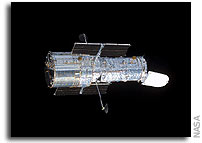NASA Hubble Space Telescope Daily Report # 4469

Notice: Due to the conversion of some ACS WFC or HRC observations into WFPC2, or NICMOS observations after the loss of ACS CCD science capability in January, there may be an occasional discrepancy between a proposal’s listed (and correct) instrument usage and the abstract that follows it.
HUBBLE SPACE TELESCOPE DAILY REPORT # 4469
– Continuing to collect World Class Science
PERIOD COVERED: UT October 16, 2007 (DOY 289)
OBSERVATIONS SCHEDULED
WFPC2 10925
Imaging the Nearest Damped Lyman Alpha Absorbers
We propose to acquire broad-band and H-alpha imaging of three bright, very nearby host galaxies for damped Ly-alpha absorbers {DLAs}. Our targets are the only DLA hosts at z < 0.03 {i.e., spatial resolutions of < 1.2 kpc}. The purpose of these observations is to discover the detailed morphology and kinematics and thus the origins of the gas giving rise to DLAs. While ground-based spectroscopy of DLAs is used to infer indirectly the evolution of galaxy metallicity and thick disk kinematics out to z > 4, only with HST imaging of the very lowest redshift DLA galaxies can we discover these relationships directly. In conjunction with H I 21-cm VLA emission maps, broad-band and H-alpha images of these DLAs will allow us to determine: {1} the sites of active star formation in the host galaxies and their relationship to the QSO sightline, {2} the presence of stellar streams, supernova shells, or bipolar “superwind” outflows in DLA host galaxies, and {3} the detailed spiral structure of the host galaxies, which will allow us to use the lower resolution H I 21-cm emission line images to determine unambiguous DLA kinematics with respect to the host galaxy {i.e., is the DLA rotating with the disk?}. Thus, the high resolution imaging will allow us to correctly interpret the kinematics and metallicity information provided by the H I 21-cm VLA maps and HST UV spectroscopy to better inform the high-z results.
WFPC2 11141
White dwarfs in the open star cluster NGC 188
White dwarf cooling sequences represent the only ways in which we can determine ages of Galactic components such as the disk and the halo, and they are an independent check on main sequence ages of globular star clusters. These age measurements rely heavily on theoretical cooling models, many of which disagree by as much as a few gigayears for the coolest white dwarfs. Further, observations of the white dwarf sequence in the super metal- rich open cluster NGC 6791 have found a white dwarf age several gigayears younger than the accepted cluster age determined by main-sequence fitting. The white dwarf sequence of the solar-metallicity, 7-Gyr old open cluster NGC 188 can provide some much-needed insight into these uncertainties, but previous HST observations were too shallow to detect the oldest, faintest white dwarfs in the cluster. We propose deep imaging of two fields at the center of the cluster with the following goals: {1} To detect the end of the white dwarf cooling sequence, providing a much-needed empirical data point for cool white dwarf evolutionary models, {2} to compare the white dwarf luminosity function of NGC 188 with that of NGC 6791 to determine if the odd white dwarf sequence in the latter cluster is due to the cluster’s high metallicity or due to a shortcoming in theoretical models, and {3} to determine via photometry the masses of white dwarfs formed by solar-mass stars, a quantity not yet empirically measured.
WFPC2 11178
Probing Solar System History with Orbits, Masses, and Colors of Transneptunian Binaries
The recent discovery of numerous transneptunian binaries {TNBs} opens a window into dynamical conditions in the protoplanetary disk where they formed as well as the history of subsequent events which sculpted the outer Solar System and emplaced them onto their present day heliocentric orbits. To date, at least 47 TNBs have been discovered, but only about a dozen have had their mutual orbits and separate colors determined, frustrating their use to investigate numerous important scientific questions. The current shortage of data especially cripples scientific investigations requiring statistical comparisons among the ensemble characteristics. We propose to obtain sufficient astrometry and photometry of 23 TNBs to compute their mutual orbits and system masses and to determine separate primary and secondary colors, roughly tripling the sample for which this information is known, as well as extending it to include systems of two near-equal size bodies. To make the most efficient possible use of HST, we will use a Monte Carlo technique to optimally schedule our observations.
FLIGHT OPERATIONS SUMMARY:
Significant Spacecraft Anomalies: (The following are preliminary reports of potential non-nominal performance that will be investigated.)
HSTARS: (None)
COMPLETED OPS REQUEST: (None)
COMPLETED OPS NOTES: (None)
SCHEDULED SUCCESSFUL
FGS GSacq 04 04
FGS REacq 11 11
OBAD with Maneuver 30 30
SIGNIFICANT EVENTS:
Gyro 2’s second flex lead failed on DOY (278) 10/05/07. An increase in the gyro’s heater duty cycle from 10-12% to 26-38% revealed that additional heater power was compensating for the absence of motor current. The second flex lead failure was expected. The first flex lead failed on August 31, 2007, after which Gyro 6 was turned on. The second flex lead’s failure did not impact HST’s operation.









